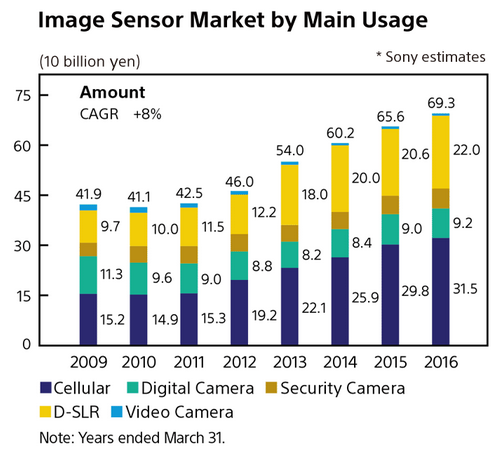CCD/CMOS Image Sensors - 2020

An image sensor is a device that converts an optical image into an electronic signal (convert light into electrons).
We have two types of image sensors:
CCD (charge coupled device) image sensor or a CMOS (complementary metal oxide semiconductor) sensor. Both types of sensor accomplish the same task of capturing light and converting it into electrical signals.
Each has unique strengths and weaknesses giving advantages in different applications.
CCDs tend to be used in cameras that focus on high-quality images with lots of pixels and excellent light sensitivity. CMOS sensors traditionally have lower quality, lower resolution and lower sensitivity. CMOS sensors are just now improving to the point where they reach near parity with CCD devices in some applications. CMOS cameras are usually less expensive and have great battery life.
The processes are:
- The sensor used in a digital camera has a 2-D array of thousands or millions of tiny solar cells, each of which transforms the light from one small portion of the image into electrons.

Picture sourse: CCD & CMOS
- Each cell of a CCD image sensor is an analog device. When light strikes the chip it is held as a small electrical charge in each photo sensor. The charges are converted to voltage one pixel at a time as they are read from the chip. Additional circuitry in the camera converts the voltage into digital information.
- A CMOS imaging chip is a type of active pixel sensor made using the CMOS semiconductor process. Extra circuitry next to each photo sensor converts the light energy to a voltage. Additional circuitry on the chip may be included to convert the voltage to digital data.
- Read the value (accumulated charge) of each cell in the image.

- In a CCD device, the charge is actually transported across the chip and read at one corner of the array. An analog-to-digital converter turns each pixel's value into a digital value.
- In most CMOS devices, there are several transistors at each pixel that amplify and move the charge using more traditional wires. The CMOS approach is more flexible because each pixel can be read individually.
It is almost impossible to make a general statement about CMOS versus CCD imagers that applies to all applications. Varied applications have varied requirements.
- CCD camera sensors are very good at capturing light. Because of the way pixels are arranged when compared to CMOS, they tend to perform a lot better in low-light situations.
- CMOS camera sensors, which are less light-sensitive, often have to be compensated for with the introduction of ISO, which introduces noise (grain) to the image.
- CMOS camera sensors have an advantage when facing a white background as CCD camera sensors can present a smearing in brightly lit objects.
- CMOS camera sensors also consume a lot less energy than CCD camera sensors. In fact, this energy consumption is cut down in some cases by a factor of 10.
- CCD camera sensors also have an advantage when it comes to rolling shutter wobble (also known as jellification) when an image is moved or twisted. This wobble is present on CMOS camera sensors due to the rolling shutter, while CCD camera sensors are practically immune to this issue.
- Newer CMOS camera sensors are becoming less sensitive to the movement of a camera as they capture images faster, though they can still present the problem in certain circumstances.
Which one?
Some applications are best served by CMOS imagers, some by CCDs.
CMOS camera sensors are cheaper and more energy efficient.
CCD camera sensors are more light sensitive and less prone to rolling shutter wobble.


Ph.D. / Golden Gate Ave, San Francisco / Seoul National Univ / Carnegie Mellon / UC Berkeley / DevOps / Deep Learning / Visualization